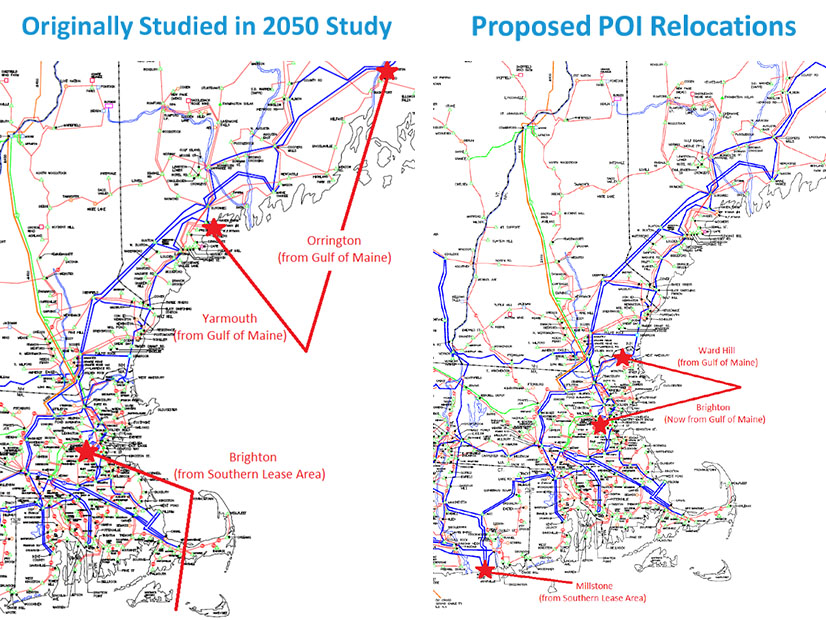Building on its 2050 Transmission Study, ISO-NE plans to study the effects of shifting two offshore wind points of interconnection (POIs) from Maine to Massachusetts and analyze regional offshore wind interconnection points, the RTO told its Planning Advisory Committee (PAC) on March 20.
The 2050 Transmission Study found the transmission upgrades to meet the region’s projected 57-GW 2050 peak load will cost $22 billion to $26 billion. One key constraint identified by the study was the region’s ability to send power from renewables in Maine and New Hampshire south to meet load in the Boston area. (See ISO-NE Prices Transmission Upgrades Needed by 2050: up to $26B.)
These results are partially contingent on where ISO-NE has modeled offshore wind projects connecting to the grid, locations that are hardly set in stone.
The finalized Gulf of Maine Wind Energy Area released March 15 (see BOEM Designates Gulf of Maine Wind Energy Area.) is located farther south than ISO-NE initially expected, with much of the lease area “as close, or closer, to Boston as it is to Maine,” Dan Schwarting of ISO-NE told the PAC.
In response to stakeholder feedback, ISO-NE is proposing to essentially rerun the 2050 Transmission Study with two POIs shifted from Maine to Massachusetts to see if it would reduce the scale and cost of transmission upgrades.
“These changes result in very little change in the mileage of offshore cables but are expected to significantly reduce stress on the Maine-New Hampshire and North-South interfaces,” Schwarting said.
Schwarting added that ISO-NE does not expect the changes to eliminate the need for north-to-south upgrades, but that the RTO anticipates “at least some of the upgrades would fall off the list.”
Additionally, ISO-NE will conduct a “high-level screening of various offshore wind points of interconnection” to provide general information on transmission constraints at different POIs and outline “how much offshore wind can realistically be interconnected into different parts of New England before major transmission upgrades are required.”
This analysis will be based on loads projected for 2033, instead of projections out to 2050, given the uncertainty of projecting generation and load data beyond 10 years. While the 2050 Transmission Study modeled offshore wind at reduced output levels “to ensure that load could be reliably served during low-wind peak conditions,” the POI screening will study wind projects at their full nameplate capacity.
ISO-NE will study the POIs up to a capacity of 2,400 MW to determine “an approximate maximum interconnection size before major transmission upgrades are required.”
While ISO-NE’s loss-of-source limit constrains single points of interconnection to 1,200 MW, the RTO is leading an effort with PJM and NYISO to study raising the limit to 2,000 MW.
ISO-NE is planning to study sites independently and then consider combinations of feasible POIs to see which can be used concurrently and which are “mutually exclusive,” Schwarting said.
Schwarting emphasized that the screening “is not a full interconnection study and does not replace the need for such a study.”
Several stakeholders supported the proposals but cautioned that transmission-system constraints are just one factor in the selection of a POI.
“There’s a whole lot that goes into interconnecting offshore wind at a particular site,” said Dave Burnham, director of transmission policy at Eversource. “[ISO-NE] is really only looking at a sliver at what it’s going to take.”
Bob Stein of Signal Hill Consulting Group said moving interconnection points from Maine to Massachusetts could bring political challenges due to the local economic benefits that are expected to accompany POIs.
“There’s a potential political problem with what good engineering suggests we should do,” Stein said.
ISO-NE is asking for stakeholder feedback on the proposal by April 4, and anticipates results “at some point in quarter three of 2024.”



